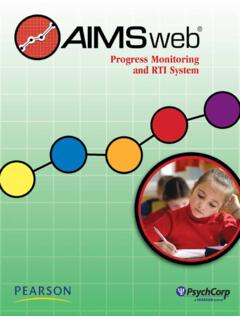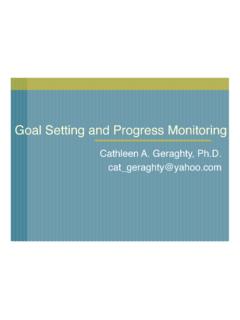Transcription of Universal Screening: Occurs in Fall, Winter, and Spring
1 AIMSweb Step By Step Process Mapping Students Native Scores to Teacher and Principal Evaluation Metric 1 Universal screening : Occurs in fall , winter , and Spring Step 1 Establishing an Independent Examiner and/or Scorer For AIMSweb Reading Curriculum-Based Measurement, Test of Early Literacy, and Test of Early Numeracy which are administered individually to students the school or LEA will provide an independent examiner. Typically a classroom teacher administers and scores these measures, but criteria for the Teacher and Principal evaluation require an educator other than the classroom teacher or principal being evaluated to administer and score the measures. The other AIMSweb measures, which are group administered, could either be given by the teacher but scored by an independent scorer in accord with NYS APPR guidelines or administered and scored by an independent examiner.
2 Step 2 Administering and Scoring the Measure Group administration (Spelling, Written Expression, M-CAP, and M-COMP) For group-administered measures, the teacher or other examiner will administer the measure to an entire class at one time. Each student will write his or her responses on a printed test form or test booklet. After the completed test materials are collected, the independent examiner will score the measures using the scoring criteria provided in each measure s Administration and Scoring manual. After completing the scoring, the examiner will enter the raw scores online (see below). Individual administration (Reading-CBM, Test of Early Literacy, Test of Early Numeracy, and MIDE [Spanish Early Literacy]) Each of these measures is administered one-on-one to a student by an independent examiner.
3 Either the paper-and-pencil or Browser-based Scoring method may be used. Paper-and-pencil The independent examiner will present the test material (either with a printed page or through oral presentation) to the student and will record the student s correct and incorrect responses on a printed answer key as the student completes the task. After administration, the examiner will calculate the student s raw score and will enter the raw score online (see below). Browser-based Scoring The independent examiner and the student will be situated so that the AIMSweb input screen is not visible to the student. The Manager of the account will have The first three steps in this procedure involve administering the AIMSweb measure and accessing the student s raw score on the assessment. AIMSweb Step By Step Process Mapping Students Native Scores to Teacher and Principal Evaluation Metric 2 already uploaded student rosters and created logins for the independent examiners.
4 The independent examiner will login to the AIMSweb system, view the Class list, and select the Access now link for a particular student. This accesses the Browser Scoring option for the assessment. The student will read the test content on a printed form or hear the test stimulus spoken by the examiner (depending on the measure) and will respond orally. The examiner will record the student s responses as they are given by clicking on the input screen. After administering the measure, the independent examiner will return to the Class list online. Step 3 Accessing the Scoring System If the examiner is not using Browser-based Scoring, the examiner will enter the raw score online. The Manager of the account will have already uploaded student rosters and created logins for the independent examiners. The independent examiner will login to the AIMSweb system, view the Class list, and select the Access now link for a particular student to enter the raw score.
5 If the examiner is using Browser-based Scoring, the score will automatically be uploaded at the completion of the test administration. Step 4 Calculating Rate of Improvement (ROI) Each student s rate of improvement (ROI) and growth percentile on an AIMSweb measure would be computed in four steps. 1. Subtracting the fall screening raw score from the Spring screening raw score; 2. Dividing the result by 36 weeks and rounding to 2 decimal places; 3. Converting the result to a growth (ROI) percentile rank using AIMSweb growth norms; and 4. Converting the growth percentile to a point value to be used in calculating the educator evaluation score. If a student lacks a fall or a Spring score, ROI would be computed by subtracting the fall raw score from the winter raw score or the winter raw score from the Spring raw score.
6 The result is then divided by 18 weeks. For a school that conducts AIMSweb Universal screening (benchmarking) during fall , winter , and Spring , the following procedure would be used to map students native scores for growth to metrics for educator evaluation. AIMSweb Step By Step Process Mapping Students Native Scores to Teacher and Principal Evaluation Metric 3 Here s an example of how to do the calculation from the student s raw scores to an evaluation score for the educator, for a Grade 3 student being assessed with Reading-CBM. 1. A student s raw score on the fall benchmark might be 95 (58th percentile on National Norms) followed by a raw score of 140 on the Spring benchmark (64th percentile). Subtracting the fall score from the Spring score gives a result of 45. 140 95 = 45 2. This result is divided by 36, providing an answer of for the student s ROI.
7 45/36 = as student s ROI 3. From the AIMSweb growth norms, each student s ROI is converted to a national percentile rank. = 65th percentile for student growth (per AIMSweb growth norms) That is, this student improved faster than about two-thirds of Grade 3 students whose initial ( fall ) score was at a similar level. Note: the AIMSweb data management system makes these calculations for you. 4. The student s growth percentile is converted to a point value as shown in the crosswalk below. Student growth Percentile Points 0-20 scale 0-15 scale 80-99 20 15 60-79 15 40-59 10 20-39 5 1-19 0 0 Step 5 Finding the Educator Evaluation Score The teacher s evaluation score would be the average point value for students in the class. Find the average point value for students in the class by 1. Summing the individual students point values, 2.
8 Dividing by the number of students, and 3. Rounding to one decimal place. This recommended mapping method applies to principals as well as to teachers. For a principal, the evaluation score would be the average point score for all the students in the school. AIMSweb Step By Step Process Mapping Students Native Scores to Teacher and Principal Evaluation Metric 4 Step 6 Interpreting the Educator Evaluation Score This educator score has a possible range from 0 (if all students ROIs are in the bottom 20% of national norms) to 20 or 15 (if all students have ROIs in the top 20%). The educator score can be interpreted by referring to the associated percentile ranges in the crosswalk table above. For example, a teacher score of would indicate that ROIs for this educator s students tend to be somewhat above the national average.
9 For teacher evaluation, AIMSweb measures that are individually administered (Reading Curriculum-Based Measurement, Tests of Early Literacy, and Test of Early Numeracy) would be given by an independent examiner. The other AIMSweb measures, which are group administered, could either be given by the teacher but scored by an independent scorer in accord with NYS APPR guidelines or administered and scored by an independent examiner. This procedure would allow for the possibility of being based on New York State data in the future, if sufficient AIMSweb screening data are collected from the state to support the construction of state-specific growth norms.







